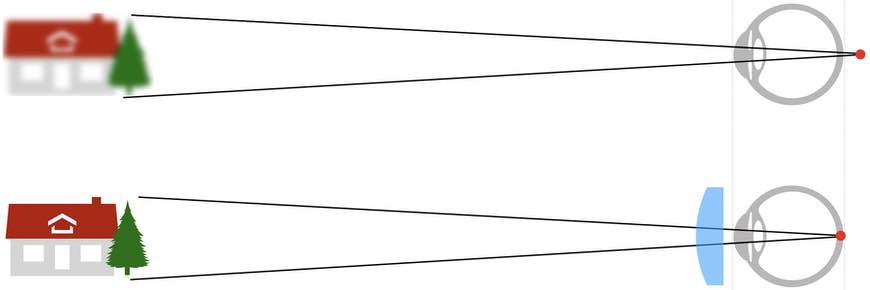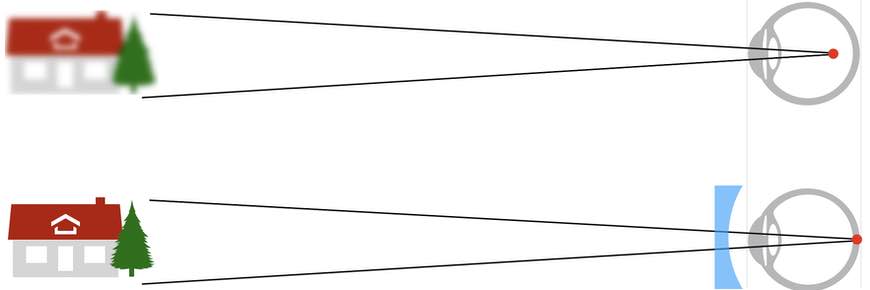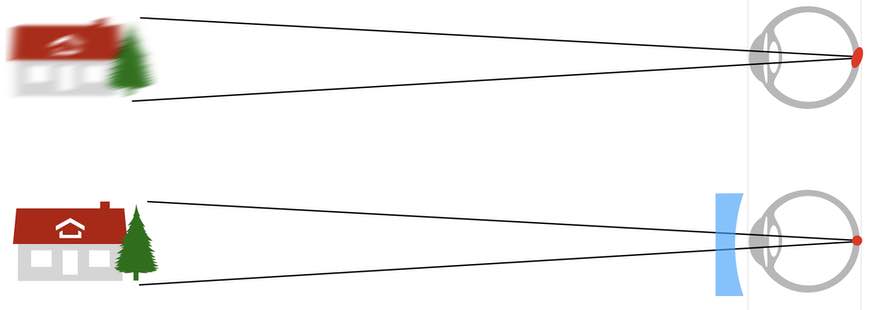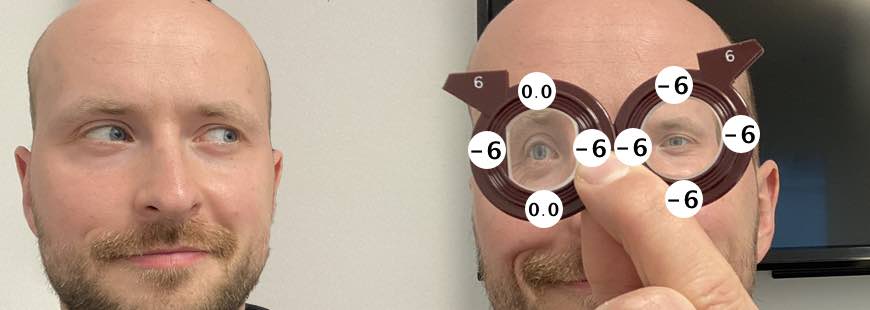Many people need single vision lenses to see clearly, but may not even know how their eyeglasses function. Magnifying single vision lenses have been used since the 13th century to magnify vision and improve vision at a distance.
Single vision lenses work by either diverging or converging light rays to correct for nearsightedness, farsightedness, and astigmatism. Adjusting light coming through the glasses reduces or increases the eye’s focusing power to reduce eyestrain.
Your eye has an optimal position in them where the light rays should come to gather to a focal point. This way you can perceive a nice and clear image. When your eyes have not enough optical power the focal point will be (theoretically speaking) behind your eye. The focal point is illustrated by the red dot in the picture below.
So when you add the right amount of optical power with a plus lens the focal point will be positioned directly on your retina. And you will see clearly in a relaxed way. This exactly is illustrated in the picture below. A plus single vision lenses work for people with hyperopia. This also leads to a slight magnifying effect. The higher the lens lower has to be the higher the magnification.

In the next picture, the opposite is the case. The focal point is positioned in front of the retina. Here in this case we need a single vision lens that diverges the light rays a bit more. With the correct lens power here again the focal point will be repositioned so it will land right on the retina. Those minus single vision lenses work for people with myopia. The byproduct in this case is a slight minification.

When you deal with single vision lenses that are only produced for people with nearsightedness (myopia) or farsightedness (hyperopia) single vision lenses work by correcting your vision with the same amount of lens power throughout the lens.
However, most people will have some amount of astigmatism in their prescription. The effect for people who have astigmatism is the focal point on the retina gets deforemd. That is illustrated on the picture below.
The focal point in this case is more shape like a football. Single vision lenses work in this case by correcting the shape back to a focal point. They do this with different lens powers in one single vision lens.

In the picture below you can see a single vision lens that works with the RX component for astigmatism. On the right, you can see a single vision lens that only corrects myopia. I wrote you the lens powers down in the picture. Look at my eyes. I added a picture of me on the left as a reference. If you look through the lens on the left side you will notice minification only takes place on one axis. In this case the horizontal one.

If you have a close look on the right side you can see a single vision lens has the same lens power through the lens. And of course therefore the same minification.
The easiest way to understand the underlying principle here is to get the idea how light travels through the lenses. If you look at any lens on the market you will notice a shape that is somewhere thicker or thinner compared to the rest of the lens’ shape. This form factor of a lens produces prismatic effects. Light just gets deviated in the direction of the thicker part of the lens.
The bigger the difference from the thickest part of the lens compared to the thinnest the stronger the lens will be.
Single vision lenses have been around for a long time, but the technology involved with them has advanced considerably through the centuries. Keep reading to learn everything about how single vision lenses work and what conditions they’re prescribed for.
What Are Single Vision Lenses Used For?
Eyeglasses exist in single vision, bifocal, and trifocal versions. Single vision eyeglasses are usually prescribed to treat the following ocular conditions:
- Nearsightedness: Nearsightedness (also known as myopia) is an eye condition where light is not focused properly on the retina, making it difficult for the nearsighted person to see objects that are far away.
- Farsightedness: Farsightedness (also known as hyperopia) is where light is positioned in the eye behind the retina rather than falling directly onto it. Farsighted people have difficulty doing close reading or focusing on nearby objects. People who read with farsightedness may be prone to eyestrain.
- Astigmatism: Rather than distorting vision at either near distance or far distance, astigmatism refers to an uneven refracting of light on the retina which causes blurry vision at any distance. With astigmatism, light focuses on multiple points within the eye instead of just one.
What is Distance in a Single Vision Prescription?
When most people get a prescription for single vision lenses, they’re getting a prescription for what are known as distance lenses. These are eyeglasses that are designed to look at things that are thirty feet or more away. Distance lenses are used for the following types of activities:
- Driving
- Sports
- Work activities
- Household chores
When someone is farsighted and has presbyopia, this may prevent them from being able to read things up close. In this case, a person may be prescribed additional single-vision reading glasses that magnify their vision so they can see things close up, but these reading glasses will be useless at farther distances.
Single vision distance lenses can help people who are nearsighted see things from far away. These lenses are not good for close reading if you are older than 45 years old or other close manual work where sharp eyesight is important. If someone requires correction in both their close and distance vision, they will often be prescribed either bifocals or single vision distance lenses with supplementary reading glasses.
How Do You Know If You Have Single Vision Lenses?
The easiest way to tell if your eyeglasses are single vision lenses or not is to look through them at multiple points on the lenses. No matter where you look at a single vision lens, it will correct to the same distance. This is in contrast to bifocals, which will cause things to appear differently if you look at them through the bottom of the lens versus looking at them through the top.
Can I Wear Single Vision Lenses All the Time?
There are no issues involved with wearing single vision lenses throughout the day, though some people may only require single vision lenses for specific activities such as reading, driving, or watching a movie. For people who would prefer to wear their glasses throughout the day, two myths should be debunked:
- Wearing glasses will not cause your natural eyesight to worsen over time. While it might seem like you see even worse without your glasses on once you’ve gotten used to seeing through them, your eyesight will not get progressively worse as a result of wearing them.
- Wearing glasses will make you dependent on your corrective lenses. This is incorrect. While your vision may be worse without your corrective lenses, wearing them will not negatively impact your ability to see without them.
Some people may find it more comfortable to only wear their single vision lenses for activities where they need sharper vision, while others find it easier to just wear them all day long. What you choose to do is up to personal preference and the recommendations of your eye doctor.
How Much Do Single Vision Lenses Cost?
The average cost of a pair of eyeglasses without vision insurance is $238. That’s only the cost of the eyeglass frames though. The single vision lenses to fit in the eyeglasses can run from a little over a hundred dollars up to several hundred dollars depending on your prescription and where you purchase the lenses.
When to Get Single Vision Lenses
If you’ve never had eyeglasses before, the symptoms of worsening eyesight may sneak up on you over time. They are often gradual and accumulate over years of close reading, computer work, and other activities that strain the eyes. This is one of the reasons why regular eye examinations are recommended for children and adults alike.
Here are some of the symptoms you should look out for that may point to the fact that you need eyeglasses:
- Fuzziness and blurriness: If you’ve started to notice that objects in your field of vision don’t have a crisp outline and that it’s more difficult to see the contrast between objects, you might be losing vision.
- Headaches and eye fatigue: Headaches and eyestrain can be symptoms that your eyes are having to work too hard to compensate for your worsening eyesight. Investing in a pair of glasses can help prevent the pain and stress that come with trying to do close reading with poor eyesight.
- Squinting: If you find yourself squinting often to try to see at middle distances, you may be developing nearsightedness.
- Halos and glare: When eyesight begins to get weak, one of the symptoms can be the appearance of halos of light or auras around lit objects like candles, lamps, and overhead lights. These halos are more obvious under bright light.
- Night blindness: Night blindness is one of the more subtle signs of worsening eyesight since it is usually only noticed while driving at night.
This is not a comprehensive list of all the symptoms that may point to the need for single vision lenses, but these are some of the most commonly seen problems that face people before they end up getting an eyeglass prescription. Getting a prescription for single vision lenses can help reduce eyestrain from poor eyesight. It can also make driving much safer.
When to Replace Single Vision Lenses
Eyeglass lenses are usually replaced every one to four years depending on the amount of wear and tear they’ve undertaken in the course of duty on your face. Some people are more prone to scratching up their eyeglass lenses than others.
Single Vision Lenses Help Thousands See Clearly
Eyeglasses are such a commonplace sight these days that most people don’t even think twice about them. Despite this, the technology that has gone into single vision lenses has helped hundreds of thousands of people see the world more clearly over the past eight hundred years.
I hope you found the information you were looking for about single vision lenses and how they work.
I wish you a great day.
